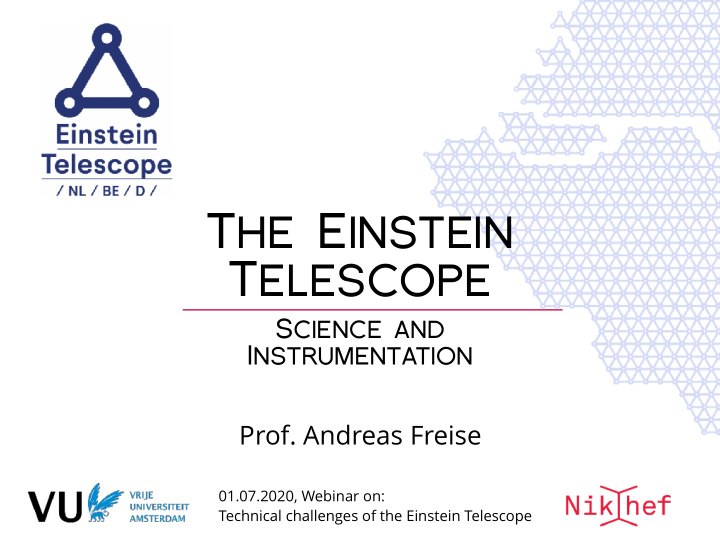



The Einstein Telescope Science and Instrumentation Prof. Andreas Freise 01.07.2020, Webinar on: Technical challenges of the Einstein Telescope
A very quick introduction to gravitational wave astronomy 2
Earth and Moon
Image: NASA, ESA, Zolt Levay (STScI)
Neutron Star Black Hole Amsterdam
Credits: R. Hurt/Caltech-JPL Credits: R. Hurt/Caltech-JPL
Observing Gravitational Waves: Gravitational waves change the distance between objects. [http://www.einstein-online.info] 7
Data GW150914 … recorded by LIGO on the 14th of September 2015, at 09:50:45 UTC
m
Ground-based network GEO600 600m LIGO Hanford 4km Virgo 3km LIGO India (approved) KAGRA 3km (under construction) LIGO Livingston 4km
Planned observations with current detectors O3 O4 O5 O1 O2 80 100 110-130 160-190 Target Mpc Mpc Mpc Mpc 330 Mpc LIGO Mpc ? 30 50 90-120 150-260 Mpc Mpc Mpc Mpc Virgo 25-130 8-25 130+ Mpc Mpc KAGRA Target 330 Mpc LIGO-India 2015 2016 2017 2018 2019 2020 2021 2022 2023 2024 2025 2026 12
The case for the Einstein Telescope 13
So, Galileo, now that you discovered Jupiter’s moons, do we need this new ‘telescope’ for anything else? 14
Probing the history of the universe Current detectors Einstein Telescope [Credits: NASA, ESA, P. Oesch and B. Robertson (University of California, Santa Cruz), and A. Feild (STScI)]
Image by Evan Hall and Salvatore Vitale
Strange Matter in Neutron Stars Figure by Jocelyn Read, see also arXiv:1306.4065 17
Einstein Telescope Vision for a new large-scale European gravitational wave observatory
Credit: LIGO/T. Pyle
km-length vs. 10 -19 m change hundreds of kW light power vs. noise from single photons
https://gwic.ligo.org/3Gsubcomm/documents/GWIC_3G_R_D_Subcommittee_report_July_2019.pdf 21
Design tool: noise budget 22
Reducing vibrations Simulation: Maria Bader ET is planned for a depth of >200m 23
Higher-power and ultra-stable lasers Image: LIGO 24
Advanced Sensing and Control Main Interferometer Beam Image: Virgo 25
Xylophone design: enabling low-frequencies Low laser power, cryogenic, long suspensions High laser power, room temperature, `normal' suspensions 26
Triangle configuration The Einstein Telescope hosts three independent detectors in a triangle configuration Provides: • full signal capture in both polarisations • redundancy for 24/7 operation x + 6 laser interferometers, each 10km long! 27
Large underground facility 29
Einstein Telescope (ET) The Einstein Telescope is the vision for a European GW Observatory, a large underground facility with a 50+ years lifespan , expected to host a number of di ff erent experiment/technologies. Timeline: • 2010 ET conceptual design completed • 2020 Forming the ET collaboration, design update • 2021 ESFRI roadmap • 2023 Site Selection • 2025 Full Technical Design • 2026 Infrastructure realisation start (excavation, ….) • 2032+: installation / commissioning / operation 30
ET Site Selection ET has two site candidates with community support and political support: a) Limburg, a cross-border region in the Netherlands, Belgium, Germany, and b) Sardinia Italy [Michele Punturo] The site will be chosen after detailed studies on seismic activity. But many other aspects will drive the decision, including industry engagement and socio-economic returns. 31
ETpathfinder R&D laboratory Focus of ETpathfinder: • new mirror material → silicon • cold mirrors → 10K to 120K • new wavelengths → 1.5-2.1 𝝂 m • quantum noise suppression Not the real focus, but also • 10 − 8 mBar vacuum system • modern controls technology • active vibration attenuation • lots of optics: lasers, mirrors, etc.
More details on the technology in the next talk.
...end A. Freise 34
Extra Slides
Interferometer R+D Table-top Numerical interferometry modelling A. Freise 36
From Idea to Implementation Numerical computations Detector system construction Analytic computations Detector Idea commissioning Table-top tests Prototype interferometers 10 to 30 years is a good time scale to go from idea to an implementation/application of a new concept or technology 37
Recommend
More recommend